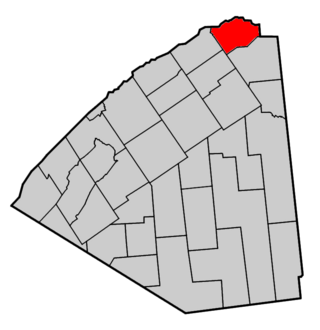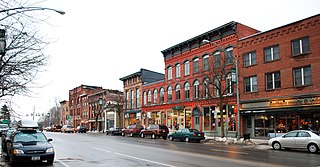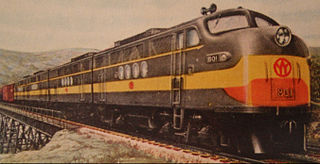
Canton is an incorporated town in St. Lawrence County, New York. The population was 11,638 at the time of the 2020 census. The town contains two villages: one also named Canton, the other named Rensselaer Falls. The town is named after the great port of Canton in China. Canton is the home of St. Lawrence University and the State University of New York at Canton. The Canton Central School District is based in the village of Canton.

Massena is a town in St. Lawrence County, New York, United States. Massena is along the county's northern border, just south of the St. Lawrence River and the Three Nations Crossing of the Canada–United States border. The population was 12,433 at the 2020 census. The town of Massena contains a village also named Massena.

Potsdam is a town in St. Lawrence County, New York, United States. The town population was 14,901 at the 2020 census. When SUNY Potsdam and Clarkson University are in session, the population increases by approximately 8,000 students. The town is named after the city of Potsdam in Germany.

The New York Central Railroad was a railroad primarily operating in the Great Lakes and Mid-Atlantic regions of the United States. The railroad primarily connected greater New York and Boston in the east with Chicago and St. Louis in the Midwest, along with the intermediate cities of Albany, Buffalo, Cleveland, Cincinnati, Detroit, Rochester and Syracuse. New York Central was headquartered in New York City's New York Central Building, adjacent to its largest station, Grand Central Terminal.

Area codes 315 and 680 are telephone area codes of the North American Numbering Plan (NANP) for the north-central area of the U.S. state of New York. Area code 315 was installed as one of the original North American area codes in 1947, while area code 680 was added to the numbering plan area (NPA) in an overlay plan in 2017.

The Michigan Central Railroad was originally chartered in 1832 to establish rail service between Detroit, Michigan, and St. Joseph, Michigan. The railroad later operated in the states of Michigan, Indiana, and Illinois in the United States and the province of Ontario in Canada. After about 1867 the railroad was controlled by the New York Central Railroad, which later became part of Penn Central and then Conrail. After the 1998 Conrail breakup, Norfolk Southern Railway now owns much of the former Michigan Central trackage.

The Ontario Midland Railroad Corporation is an American Class III railroad company operating in western New York. As of September 2022, it became a subsidiary of the Livonia, Avon & Lakeville Railroad (LAL).

The New York, Ontario and Western Railway, commonly known as the O&W or NYO&W, was a regional railroad founded in 1868. The last train ran from Norwich, New York, to Middletown, New York, in 1957, after which it was ordered liquidated by a U.S. bankruptcy judge. It was the first Class I U.S. railroad to be abandoned in its entirety.
The Lake Ontario Shore Railroad (LOSRR) was a short-lived common carrier railroad in New York that was absorbed by the Rome, Watertown and Ogdensburg Railroad.

The Empire State Express was one of the named passenger trains and onetime flagship of the New York Central & Hudson River Railroad. On September 14, 1891, it covered the 436 miles (702 kilometers) between New York City and Buffalo in 7 hours and 6 minutes, averaging 61.4 miles-per-hour (98.8 km/h), with a top speed of 82 mph (132 km/h).
The Charlotte Running Track, locally known as the Charlotte Runner or the Charlotte Branch, is a CSX Transportation-controlled branch line located in Rochester, New York. The track is roughly 9 miles (14 km) in length, beginning at control point 373 on CSX's Rochester Subdivision and snaking north through the residential and industrial sections of Rochester's west side before turning to the west in Charlotte onto what was the Hojack Line, terminating just to the west of Rochester Gas and Electric's Russell Power Plant in Greece.
The St. Lawrence Subdivision is a railroad line owned by CSX Transportation in the U.S. state of New York. The line runs from Syracuse, New York, north to Massena, New York, along a former New York Central Railroad line. At its south end, it meets the Syracuse Terminal Subdivision; its north end is at the south end of the Montreal Subdivision. Along the way it junctions with the Fulton Subdivision at Woodard, New York,.
The Ogdensburg and Lake Champlain Railroad was founded in 1849 as the Northern Railroad running from Ogdensburg to Rouses Point, New York. The 118-mile (190 km) railroad was leased by rival Central Vermont Railroad for several decades, ending in 1896. It was purchased in 1901 by the Rutland Railroad and became its Ogdensburg Division.
The Cayuga Hojack Trail is one of two Hojack trails in New York, the other being the Webster Hojack Trail in Webster. Both are built on remnants of the Hojack, a common name for the Rome, Watertown and Ogdensburg Railroad. Cayuga County maintains the 8.5-mile (13.7 km) trail, which intersects the Cato–Fair Haven Trail south of Fair Haven. Both trails are used by snowmobiles in winter, equestrians, bicyclists, and hikers in the summer.
The Webster Hojack Trail is one of two Hojack trails in New York, the other being the Cayuga Hojack Trail. Both are built on remnants of the Hojack, a common name for the Rome, Watertown and Ogdensburg Railroad. The Friends of Webster Trails maintains this 3.5-mile-long (5.6 km) trail, fully within the Town of Webster. It begins at Phillips Road near Route 104 east of the village and runs along the right of way, now owned by Rochester Gas & Electric, to Lake Road.

Thendara station is the Adirondack Scenic Railroad's longest-duration northern terminus, and is near Thendara, New York. It is served by trains heading south to Utica beginning around the month of May each year. Trains continue along the 57-mile route along the Moose River in Adirondack Park. In the Winter, the right-of-way is used as a major snowmobile trail in the area after trains stop running in October. The resort village of Old Forge is 1.9 miles northeast of Thendara.
The Syracuse, Phoenix and Oswego Railroad was chartered on November 29, 1871, and had a route from Woodard, located north of Syracuse, New York, to Fulton, New York, a distance of 17.11 miles (27.54 km). They merged with the Syracuse Northwestern Railroad on June 10, 1875, and incorporated as Syracuse, Phoenix and Oswego Railway on February 16, 1885.
The Syracuse Northwestern Railroad was established in 1874 to construct a railroad from Woodard to Haymarket Square in Syracuse, New York. The company was consolidated under the Syracuse, Phoenix and Oswego Railroad in 1875 and was sold under a judgement in 1885 under the name Syracuse, Phoenix and Oswego Railway.
Philadelphia is a town in Jefferson County, New York, United States. The population was 1,964 at the 2020 census.













